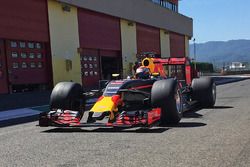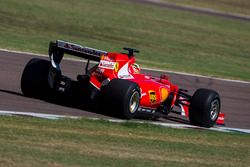Analysis: How the FIA makes sure Pirelli testers get no advantage
Testing duties for Pirelli's new rubber has fallen to Formula 1's top three teams. But will it give Mercedes, Red Bull, and Ferrari an advantage? Adam Cooper investigates.

Photo by: XPB Images




































This week's 2017 Pirelli tyre tests have put a focus on the Italian company's preparations for next season, when wider tyres and higher downforce levels present a new challenge to both the tyre maker and the teams.
It took months of discussions, but Pirelli, the FIA, and the teams were finally able to agree on a carefully-structured test programme, using 2015 cars modified to accept the new tyre sizes, and simulate next year's downforce levels.
Ferrari and Red Bull have already run at Fiorano and Mugello respectively, and Mercedes will join in at Barcelona on September 6-7. The teams will have a total of eight days of running apiece. Each team will devote one two-day test to the wets/inters, one to hards/mediums, and one to softs/supersofts/ultrasofts.
They will then all appear together for final validation in Abu Dhabi after the last race of the season.
So why are these three teams doing all the testing? All entrants were given a chance to pitch for the job, but four ruled themselves out straight away. Haas didn't exist last year and thus has no 2015 car, while Renault, Toro Rosso and Manor have all changed engine suppliers, and thus can't run an earlier model.
Then it was a simple question of resources. Who had the money, manpower and time to devote to creating a 'mule' car while also working on the current model and ramping up R&D for the 2017 car? Even mighty McLaren opted out in order to focus on its main projects. So that left us with the three teams who got the job.
The question that many people are asking is what sort of advantage they will gain relative to those who don't take part in the testing. It's a perfectly valid one to ask, especially given that many F1 observers believe that Lotus benefited when it donated a car for Pirelli testing a few years ago, and was very competitive the following season.
The FIA has done its best to address such concerns by putting in place provisions to ensure that there is a level playing field.
It has done so through a series of Technical Directives issued by Charlie Whiting on the subject of the "Tyre Development Campaign", with the most recent emerging on July 31, the day before the first Fiorano test. The document gives us a fascinating insight into how the test programme is operating.
The cars
The general idea of using 2015 cars was to prevent teams learning much that would be of use for their current campaigns, as well as the fact that they had suitable chassis lying around unused.
The big challenge was to add downforce to bring them up to 2017 levels without giving the participating teams a head start on their own aero development for next season by anticipating the future rules. In other words the downforce had to be created by other means.
At the same time any development work on the hybrid cars had to stand outside the ATR, or the FIA's aerodynamic testing restrictions, so that participating teams did not have to give up any precious resources (wind tunnel time or CFD Teraflops) that would otherwise be devoted to 2016 or '17.
In its "Guidelines for Hybrid Cars Development for the 2017 Tyre Testing Campaign" the FIA thus determined that the test cars: "Not be representative of a car complying with the 2017 regulations, in order to make the development work to achieve them irrelevant to 2017 car development and allow it to sit outside the ATR.
"Be achieved in the simplest and cheapest possible way in order to limit the resources needed to develop these hybrid cars.
"Given the variability of the current 2017 performance estimates, base car performance and methods of assessing them between the teams, a target downforce level has been set for each participating team relative to its 2015 Melbourne car level."
In addition the starting point was somewhat compromised – teams were not simply adding downforce to a standard 2015 car, but one with a wider track and wider tyres, and which had seriously compromised aerodynamics.
Indeed the FIA notes: "Reaching these levels of aerodynamic loads in a simple and non-representative way is bound to be very challenging, especially as widening the track and fitting the 2017 tyres will have a large detrimental effect on the base car aerodynamic performance that needs to be recovered in addition to the increase sought."
It was for this reason that the FIA has given the teams a lot of aerodynamic freedom, and the most obvious reflection of that are the side skirts visible in pictures of the Ferrari and Red Bull. In addition there is a lot of leeway with the floor and venturi, wings, bargeboards, a higher 'tea tray' so that the front can be run lower to the ground with a higher rake, and so on.
In order to ensure that any aerodynamic research stands outside the ATR the three teams have had to submit full details to the FIA alongside the information they are obliged to provide on their regular R&D: "All the aerodynamic development work (wind tunnel or CFD) needs to be declared in the teams's eight-weekly ATR declaration as unrestricted work and explicitly flagged as '2017 hybrid car for tyre testing'."
It adds: "Every eight-weekly ATR declaration will be accompanied by a spreadsheet detailing every wind tunnel/CFD run completed for the purpose of developing the 2017 hybrid car, which will include a description of the geometry tested and basic numbers for aerodynamic forces extracted from the teams' runlog."
As they developed the 'mule' aero kit the three teams were obliged to share their findings.
"It is in all teams participating to the testing campaign's interest to achieve the objectives in the shortest possible time while spending the minimum amount of resource and money. Furthermore, it is in all teams' interest (not only the participating ones) that the process is as fair and transparent as possible.
"Therefore, it is proposed to put a collaborative and open process in place where all participating teams update all teams on their findings and results at every TRM [Technical Regulations Meeting].
"No later than four days before each meeting, each participating team will send their up-to-date wind tunnel and CFD runlog spreadsheets to the FIA, not for disclosure but solely for the FIA to keep teams honest and avoid non-disclosure of relevant information (for example for the purpose of having other teams wasting resource on unfruitful areas)."
The testing
The FIA has put in place a detailed list of conditions for the testing "in order to minimize the disadvantage to the teams that will not participate in the testing campaign by providing all teams with the ability to run simulations based on the testing data and information to steer their 2017 car design while protecting the testing teams' IP in areas unrelated to tyre development."
Prior to the testing the teams have had to submit the following to the FIA:
"A list of the modified bodywork components when compared to a specification raced during the 2015 season.
"A list of power unit elements intended for use (as typically provided prior to a race Event using the standard templates).
"All relevant information on electronic systems intended for use (as typically provided prior to a race Event using the standard templates). Should any changes be necessary to any of the above during the testing campaign the same procedure would apply ahead of the following test day.
"Additionally, any power unit element intended to be used during the campaign must have been inspected and sealed by the FIA prior to use, ideally during a race Event for convenience reasons.
"No test parts will be permitted and any modification or change to a test car will be shared with all the teams."
The FIA has mandated a very detailed list of sensors and so on that Pirelli requires to be fitted to the car, and that was updated in the latest Technical Directive.
It includes wireless pressure monitoring systems, infra red cameras, and infra red temperature sensors front and rear. Care has been taken to ensure that teams cannot gather their own extra information.
"Participating teams will be required to submit SECU configuration files and make available to the FIA the data logged by the SECU either via their team area on the FIA FTP or other media agreed with the FIA.
"No additional logging equipment may be used unless it is specifically intended to collect additional information about the tyres that is deemed useful by Pirelli, subject to the approval of the FIA. In this case, all of the data collected must be made available to all teams."
The key thing, as with previous Pirelli tyre testing, is that the teams don't get details of exactly what they are running from set to set, and that all running is controlled by the tyre supplier.
"The testing will be blind, no details on the prototypes tested will be communicated to the teams, only the necessary information to engineer the car will be provided.
"Run plans will be entirely defined by the tyre supplier and agreed with the FIA. Observers appointed by the FIA will be present at each test to monitor that only the tests requested by the tyre supplier are performed. FIA observers will also have driver radio and full access to the teams."
In addition, "Non-participating teams will be permitted to send an observer to the test."
The results
After the tests Pirelli is obliged to share the results with all the teams, in order to guarantee transparency.
"Comprehensive end-of-test reports will be circulated to all the teams by Pirelli. The reports shall include run by-run and where applicable lap-by-lap summaries of:
- Lap times and sector times.
- Wear profiles.
- Measured grip and cornering stiffness per axle (calculated from the telemetry data). These will be compared to an average 2016 value for this compound and to baseline.
- Measured stabilised carcass temperature, stabilised running pressure and their delta to starting values. These will be compared to an average 2016 value for this compound and to baseline.
- Rolling radius, loaded radius and vertical stiffness (measured during indoor testing) as deltas to typical 2016 values and to baseline.
- Normalised information related to car behaviour coming from the analysis of the telemetry vs baseline, e.g. under/over-steer metrics.
- Driver comments (as recorded by Pirelli)."
In addition the three teams are obliged to share information with their rivals.
"Each participating team will circulate an end-of-test report to all teams and Pirelli. The reports shall include, for each run:
- Aero-balance, mechanical balance and weight distribution as deltas for the 2017 hybrid car compared to a normal balance on a 2016 car and to baseline.
- Driver comments (as recorded by the team)."
In addition to these Pirelli and team reports other teams can make a request to the FIA if they wish to receive additional data, and "the FIA will change the reporting requirements if judged appropriate."
So all-in-all a pretty substantial set of rules and restrictions from the FIA, which must provide some comfort to the eight teams that are not taking part – and indeed ensure that the three that are doing the testing are a little less suspicious of each other.
Nevertheless it's logical to assume that there must be some benefit for Mercedes, Red Bull and Ferrari and their race drivers to be derived from getting an early feel for the new tyres, and from attempting to push development in a direction that might suit the concept of their 2017 cars.
However, given that they are in any case the top three teams of the current era it won't be very easy to use next year's results to judge if they did...
Be part of Motorsport community
Join the conversationShare Or Save This Story
Subscribe and access Motorsport.com with your ad-blocker.
From Formula 1 to MotoGP we report straight from the paddock because we love our sport, just like you. In order to keep delivering our expert journalism, our website uses advertising. Still, we want to give you the opportunity to enjoy an ad-free and tracker-free website and to continue using your adblocker.



















Top Comments